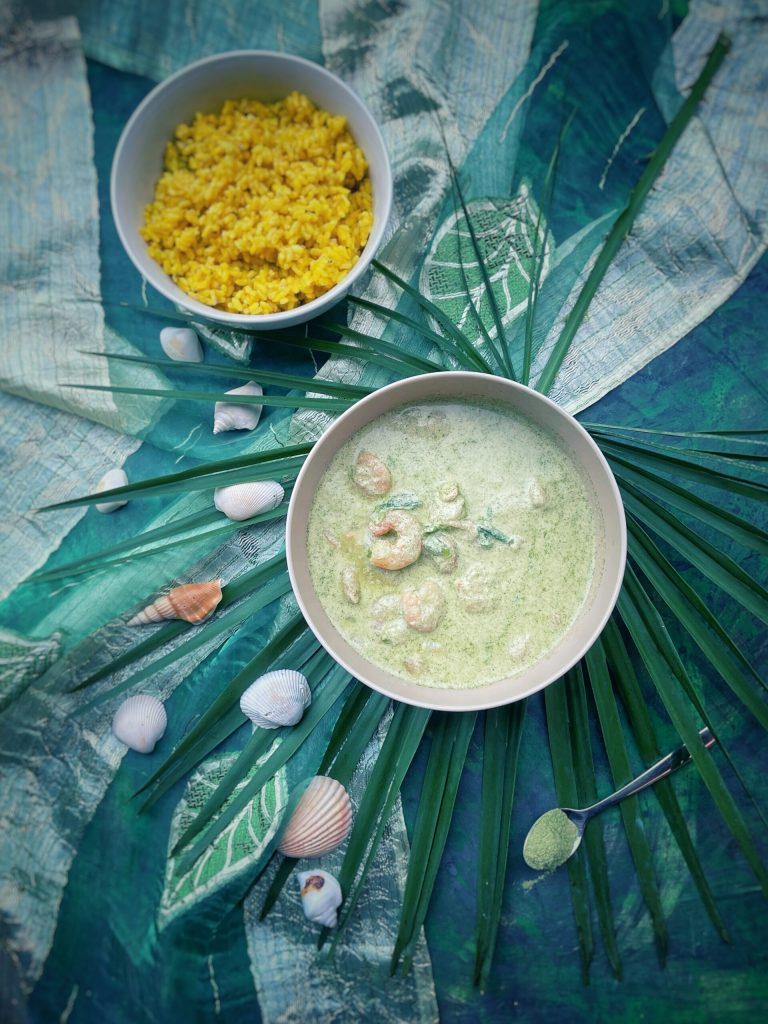Ginataang Hipon at Malunggay can be translated as coconut soup with shrimp and moringa, or also “Ginataang Sugpo at Malunggay” if using larger shrimps or prawns.
Ginataan = cooked in coconut milk
Hipon/Sugpo = shrimp
Malunggay = moringa leaves
It is a popular recipe in coastal Filipino communities, served with white rice.
Ginataan (pronounced: GHEE-nah-ta-AN) is a Filipino term that refers to food cooked with gata, or coconut milk.
Due to the general nature of the term, it can refer to a number of different dishes, each called ginataan but distinct from one another, and on the blog, you will also find:

- Difficulty: Easy
- Cost: Affordable
- Preparation time: 5 Minutes
- Portions: 2 People
- Cooking methods: Stove
- Cuisine: Filipino
- Seasonality: All Seasons
Ingredients
- 7 oz shrimp
- 1 onion
- 2 cloves garlic
- as needed vegetable oil
- 7 oz coconut milk
- 1 cup moringa leaves (or 2 teaspoons powdered)
- as needed salt and pepper
Steps
Sauté onion, garlic, and ginger in oil for 2-3 min until fragrant.
Add coconut milk (avoid strong boiling to prevent separation) and cook on medium flame for 5-7 min.
Add shrimp and cook until they turn pink and opaque (about 5 min).
Adjust salt or add a bit of bagoong/fish sauce if desired.
Add malunggay (moringa) leaves or powder.
Cook for another 2-3 minutes.
Serve hot with rice, I flavored it with turmeric.
FAQ (Frequently Asked Questions)
What is moringa?
Moringa is traditionally used in cooking in various parts of the world, especially in India, Sri Lanka, Africa, and the Philippines, where fresh leaves, pods (drumsticks), and sometimes the powder are used.
Moringa (Moringa oleifera) is a tropical plant native to India and Africa, also called the “miracle tree”. Its dried and ground leaves produce an intensely green powder, very rich in nutrients.
Main properties of moringa powder:
Complete vegetable proteins (contains all essential amino acids)
Vitamin C, A, and E (antioxidants)
Calcium, iron, potassium, and magnesium
Anti-inflammatory and immune-stimulating effect
Helps regulate blood sugar and cholesterol
Promotes digestion and natural energy
How to use moringa powder in cooking:
It has a herbaceous/earthy taste, similar to dried spinach or green tea. A little is enough.
Recommended dose: 1–2 teaspoons per day.
Ways to use it:
Smoothies and shakes: with banana, plant milk, and lemon
Porridge and yogurt: added at breakfast
Soups and purees: at the end of cooking to preserve nutrients
Pasta and rice: mixed with oil and lemon
Alternative pesto: with basil or arugula and a teaspoon of moringa
Raw desserts or energy balls.
Avoid prolonged cooking to prevent degradation of vitamins and antioxidants.
For the Ginataang Hipon at Malunggay recipe, I used Amoseeds moringa powder which you can purchase on www.amoseeds.it with discount code: selene10

